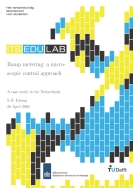Efforts have been undertaken to reduce congestion levels on the road. A traffic management solution that does not rely on the development and the enrollment of new technologies (such as connected and autonomous vehicles) and that entails a high compliance rate is ramp metering. The currently existing ramp metering control strategies are of a macroscopic nature. This means that the average occupancy or average flow values on the main lane determine the temporarily fixed cycle times for the traffic light located near the on-ramp to control the inflow from the on-ramp. In this thesis, it is investigated to what extent a microscopic approach to ramp metering would lead to less travel time delays. This approach shows a green light for the on-ramp vehicles when a gap in the main lane flow on the right lane has been detected instead of using the temporarily fixed cycle times.
A control scheme for this newly developed approach is drawn up. Moreover, computations on the location of the gap measurement loop detectors are required. To implement individual acceleration deviations between various drivers, an acceleration distribution for passenger vehicles has been composed by means of an experiment. Additionally, a distribution for trucks has been implemented as well. The vehicles in this research are limited to these two vehicle groups and both vehicles groups have a specified gap measurement loop detector on the main road. To compare the currently used macroscopic control algorithm, the newly developed microscopic control approach and the no-control alternative, simulation runs for various scenarios have been executed. These simulation are executed in OpenTrafficSim (OTS). The road layout in OTS is based on the A13 Delft-North on-ramp in the direction of Rotterdam. The simulation runs provide outputs on several Key Performance Indicators (KPIs). The main KPI is the average travel time savings per vehicle for all vehicles involved in the system. Other KPIs that have been used are the average travel time savings for the individual Origin-Destination (OD) pairs. KPIs that only apply to the alternatives with an active (microsocpic) ramp metering installation are the logged (de-)activation times, number of vehicles that received a green light in the activated time, successful merger percentages and merging vehicles that had to wait longer than the currently used maximum waiting time.
Comparing the alternatives on these KPIs for several scenarios provide some interesting insights. It was found that the proposed microscopic algorithm leads to additional travel time savings in the current road layout scenario compared to the currently used Rijkswaterstaat algorithm. This is even more when a semi-permeable lane demarcation is implemented to prevent main road vehicles from merging in the measured gaps in the flow on the right lane of the main road. However, to accomplish this gain in travel time savings, substantial main road flows and off-ramp flows are required. The same goes for the on-ramp flow. With the currently developed microscopic control approach, the truck percentage on the on-ramp should not be too high, since the control approach performs better when passenger vehicles are waiting instead of trucks. It is highly recommended to improve the control scheme when trucks are waiting. More adjustments to the developed microscopic control structure, such as a combined Rijkswaterstaat and microscopic algorithm, are proposed and it is recommended to investigate the effects of these adjustments as well.
